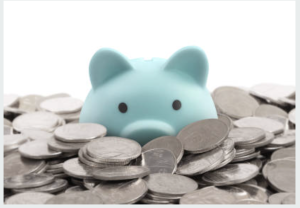Sinking funds are a simple way to save money for out-of-the-ordinary purchases. Read on to see how a sinking fund can improve your zero waste experience!
Back in 2014, I was fortunate to participate in Financial Peace University: a wonderful financial coaching seminar taught by Dave Ramsey. I highly recommend it to anyone looking to gain control of their money or learn better financial practices!
Partway through the course, we learned about the concept of a “sinking fund,” a technique in which you save a small amount of money each month for a certain amount of time to make your goal. You can learn more about on Dave Ramsey’s blog, right here.
It’s no complicated process (honestly, it’s just a structured form of saving) but the concept made a huge difference in the way that I approach saving for purchases outside my typical, monthly budget.

Sinking Fund Example:
Saving for a Zero Waste Pantry
Let’s say, I’m ready to start a Zero Waste pantry but I know the purchase of that many bulk jars will cost me approximately $200, an amount that is outside my normal realm of spending.
Here are my options:
- Skip the project all-together, but keep spending small amounts on traditionally packaged groceries. Cheap short-term; extremely expensive long-term.
- Get glass jars and containers secondhand. Honestly, I would recommend this. If you have the local resources to source your containers at a thrift store, do it! You’ll save money and be able to avoid buying new manufacturing.
- Start a small sinking fund. Say, you’d like to save $200 over a period of four months. Divide the goal amount by each month (200/4=50), then save the resulting amount each month till you reach your goal!

The Difference Between Spending & Investing
I used to be an active shopper, if for no other reason than I felt a need to build up my home. Since going zero waste, Josh and I have learned the value in living a more minimalist lifestyle.
Zero Waste is one of those things that requires us to put the brakes on consumerism. Consumerism breeds greed, which breeds excess, which breeds garbage. It’s really that simple.
However, some purchases make a valuable difference long term – a Zero Waste pantry, for example. Without the tools you need to start shopping bulk, you’ll keep shopping conventionally; so why not make the investment, especially if you can use a sinking fund to save what you need?
Your Homework:
- Consider if you’ll need to make any purchases for Zero Waste in the future. They should be necessary purchases that will serve you long-term, but out-of-the-ordinary.
- Do some cost research. Check around the web to see what spending you’ll need to prepare for, assuming you choose to buy new.
- Start a sinking fund at home or through a bank account. If you’re saving a relatively small amount, you may be able to pull this off piggy bank style. However, if you’re working with a larger amount, start sending the amounts you need to your savings account then annotate them so you know each dollar’s purpose.

